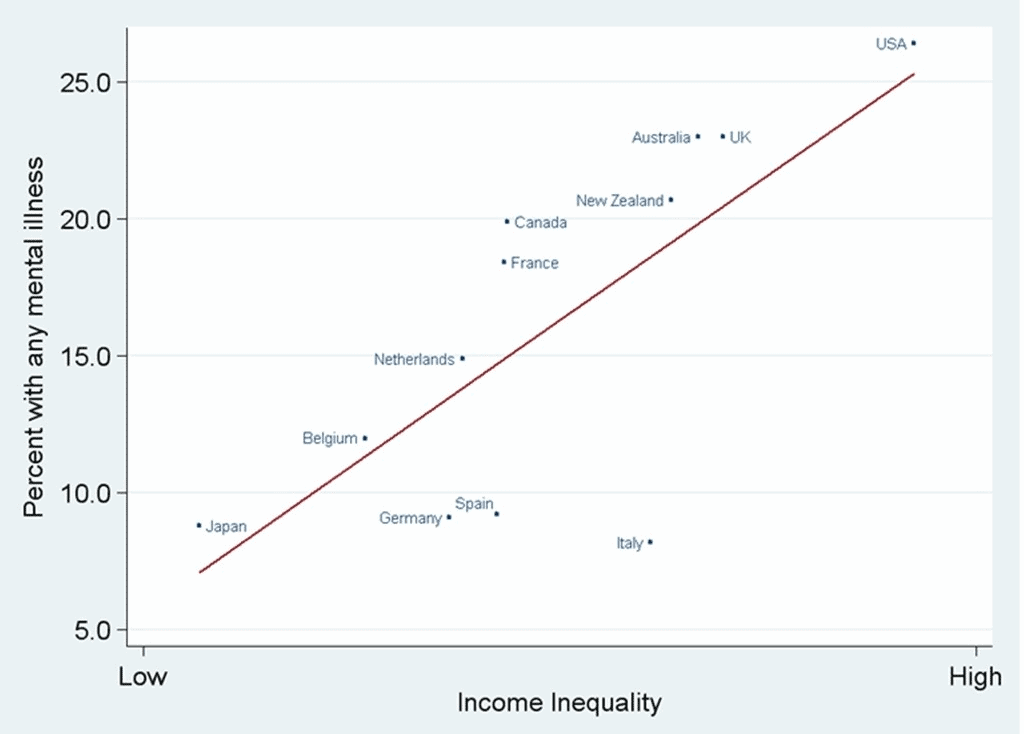
Helen Duyvestyn
(Registered Nurse, Adv. Dip Nursing, Cert. Adv. Nursing, MHSc [Mental Health])
Note — The article was checked and updated August 2023.
As a whole, five ways to well-being are to Connect with People, Be Active and exercise, Keep Learning and developing, Give back and help people when possible, and Take Notice of the world around.
Researchers and scientists believe that these activities and approach to life promote well-being and good mental health. The concepts are simple and to understand them completely, we will dive deep into each of them.
Do notice that there is no mention at all about owning things and financial success or other areas that we often attribute to making us happy.
Introduction to Wellbeing
In 2006, the United Kingdom government wanted to find out how to increase the population’s mental health and wellbeing. Over 400 experts in psychology, psychiatry, neuroscience, education and economics from across the world were asked to review current knowledge on what helps to maintain good mental health and wellbeing.

The result was Five Ways to Wellbeing, which is a set of evidence-based actions to improve personal wellbeing and mental resilience. The Mental Health Foundation of New Zealand have also adopted these concepts and use them as part of their tools to encourage active participation in improving how you feel.[1]
The concepts don’t change our circumstances as such, but bringing these actions into our everyday life can help us flourish.
Connect with People (and Pets)
A deep human need is to feel a sense of belonging and connection with others. Deep connections release oxytocin (the ‘feel good’ chemical) and can reduce cortisol levels (often associated with stress).
Even connecting with a pet has been shown to reduce blood pressure, hence the idea of animal therapy in rest homes.[2]
Connecting locally within your community can enhance feelings of trust, associated with community happiness, and can build a supportive community around you – allowing you to both give and receive support when necessary.
Connect with friends and family, but also neighbours and strangers. Smile and make conversation at the supermarket, have a chat with the neighbour, phone a friend. Be brave!
Be Active, Move and Sweat (and you’ll feel better)
Exercise shows to improve mood and has been used successfully to reduce depression and anxiety.
It has numerous health benefits, such as reducing likelihood of developing diabetes, assisting with weight loss, decreasing risk of cardiovascular disease and can improve sleep and general energy levels.[3,4,5]
RELATED — Different types of sleep: which one do we need the most?

Exercising outside is even better. It increases levels of vitamin D, exposing yourself to negative ions (which is thought to reduce depressive symptoms) and good bacteria which can improve gut health.[6]
RELATED — Vitamin D: The sunshine hormone for stronger bones
Being in “green spaces” has been suggested to promote well-being more so than being in the city.[7]

Find whatever exercise works for you; be it walking, swimming, running or star-jumps. Try to get your blood pumping and build up a sweat. Sweating can help rid the body of toxins (although this is controversial).[8]
Sitting for long periods of time has been shown to decrease your life expectancy – even if you are doing exercise outside of those times.[9]
Take Notice and See the World Around You
The Mental Health Foundation New Zealand describe this as: “Be curious and catch sight of the beautiful, remark on the unusual. Notice the changing seasons. Try savouring the moment, whether you are walking to work, eating lunch or talking to friends. Be aware of the world around you and what you are feeling.”
As we can see from the chart below spending at least 120 minutes a week in nature is associated with good health and wellbeing.

One way to do this is by developing the skill known as Mindfulness. It teaches us to be aware of the present moment, to find appreciation in the little things in life. It can also promote behavioral changes when you notice that something that you are doing no longer “resonates” with who you are or who you want to be.
RELATED — Introduction to Mindfulness: Enjoy the present moment and appreciate life
Paying attention to how you are feeling, physically and mentally, means that you are more likely to intervene earlier when you notice things aren’t right.
Having gratitude for the good things in your life enhances your happiness levels significantly and trains the brain to seek out the positive rather than being focused on the negative.
Take regular breaks in your day to look around you. Take ‘mini-moments’ to pay attention; Stop, Take a Breath, Observe where you are and what you are doing, Proceed with awareness (known as the ‘STOP’ technique). Seek out something pleasant that you can see, hear and appreciate.
Seek out something pleasant that you can see, hear and appreciate.
Keep Learning, Keep Growing and Develop More
Learning encourages social interaction and increases self-esteem and feelings of competency.
Behaviour directed by personal goals to achieve something new has been shown to increase reported life satisfaction.[10] It doesn’t matter what you choose to do; would it be to cook a special meal, take on a work related challenge or find a new hobby.
Do something which you believe you will enjoy, will give you “flow”, challenge you a little and give you a feeling of accomplishment.
Think about something which you have always dreamed of doing and set a new goal for yourself around that. Strive for something!
Give and You Will Build A Better Community

Studies in neuroscience have shown that cooperative behaviour activates reward areas of the brain, suggesting we are hardwired to enjoy helping one another.[11]
RELATED — What is Neurofeedback therapy and brain training?
Individuals actively engaged in their communities report higher well-being and their help and gestures have a knock-on effect on others. But it is not simply about a one-way transaction of giving.
Building reciprocity and mutual exchange through giving and receiving is the simplest and most fundamental way of building trust between people and creating positive social relationships and resilient communities.
The concepts are easy to incorporate into your life and although they don’t have all the answers to life’s problems, they can over time enhance your mood and help you get a little more out of life.
If you can’t wait and would like to know when the next article in the series will be coming out, you can join our healthy community and Subscribe to our Newsletter. It’s free.
Helen is a registered nurse who holds a Masters in Health Science (Mental Health) and is a trained Life Coach. She has worked for fifteen years in acute psychiatry as a psychiatric nurse and for over two years in a holistic health clinic in Central Auckland, specialising in physical health and well-being. She has trained with ACNEM (Australasian College of Nutritional and Environmental Medicine) and is a member of AIMA (Australasian Integrative Medicine Association).
Helen is passionate about empowering others through education to reach their mental health and well-being potential. Read more about Helen and her work at www.onelifenz.com
References
(1) Mental Health Foundation of New Zealand: https://mentalhealth.org.nz/
(2) Vormbrock, J. K., & Grossberg, J. M. (1988). Cardiovascular effects of human-pet dog interactions. Journal of behavioral medicine, 11(5), 509–517. https://doi.org/10.1007/BF00844843
(3) Colberg, S. R., Sigal, R. J., Fernhall, B., Regensteiner, J. G., Blissmer, B. J., Rubin, R. R., Chasan-Taber, L., Albright, A. L., Braun, B., American College of Sports Medicine, & American Diabetes Association (2010). Exercise and type 2 diabetes: the American College of Sports Medicine and the American Diabetes Association: joint position statement. Diabetes care, 33(12), e147–e167. https://doi.org/10.2337/dc10-9990
(4) Nystoriak, M. A., & Bhatnagar, A. (2018). Cardiovascular Effects and Benefits of Exercise. Frontiers in cardiovascular medicine, 5, 135. https://doi.org/10.3389/fcvm.2018.00135
(5) Dolezal, B. A., Neufeld, E. V., Boland, D. M., Martin, J. L., & Cooper, C. B. (2017). Interrelationship between Sleep and Exercise: A Systematic Review. Advances in preventive medicine, 2017, 1364387. https://doi.org/10.1155/2017/1364387
(6) Perez, V., Alexander, D. D., & Bailey, W. H. (2013). Air ions and mood outcomes: a review and meta-analysis. BMC psychiatry, 13, 29. https://doi.org/10.1186/1471-244X-13-29
(7) Dobson, J., Birch, J., Brindley, P., Henneberry, J., McEwan, K., Mears, M., … Jorgensen, A. (2021). The magic of the mundane: The vulnerable web of connections between urban nature and wellbeing. Cities, 108, 102989. https://doi.org/10.1016/j.cities.2020.102989
(8) Sears, M. E., Kerr, K. J., & Bray, R. I. (2012). Arsenic, cadmium, lead, and mercury in sweat: a systematic review. Journal of environmental and public health, 2012, 184745. https://doi.org/10.1155/2012/184745
(9) Diaz, K. M., Howard, V. J., Hutto, B., Colabianchi, N., Vena, J. E., Safford, M. M., Blair, S. N., & Hooker, S. P. (2017). Patterns of Sedentary Behavior and Mortality in U.S. Middle-Aged and Older Adults: A National Cohort Study. Annals of internal medicine, 167(7), 465–475. https://doi.org/10.7326/M17-0212
(10) Wang, W., Li, J., Sun, G. et al. Achievement goals and life satisfaction: the mediating role of perception of successful agency and the moderating role of emotion reappraisal. Psicol. Refl. Crít. 30, 25 (2017). https://doi.org/10.1186/s41155-017-0078-4
(11) Sun, P., Zheng, L., Li, L., Guo, X., Zhang, W., & Zheng, Y. (2016). The Neural Responses to Social Cooperation in Gain and Loss Context. PloS one, 11(8), e0160503. https://doi.org/10.1371/journal.pone.0160503






